Affiliated with a vivacious current of young artists melding techie chops and ’90s graphic aesthetics, the Berlin-based duo, AIDS-3D (Daniel Keller and Nik Kosmos) popped up on the radar last year when their work was featured in the New Museum’s Younger than Jesus show. Meeting viewers in real life too, their OMG Obelisk shot them from group show obscurity to having their name dropped in nearly every Frame section announcement in this year’s pre-Frieze media blitz. Yet when viewers came to Frame last week, there seemed to be some confusion: computers? curing cancer? waterfalls? So for those of you also jonesing for an answer, here are a few.
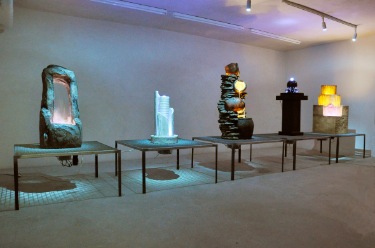
AIDS-3D, "World Community Water Features," 2010. Cast fiberglass, Fit PC 2, and water, installation view. Courtesy the artists and Gentili Apri.
Alex Freedman: In Dispersion, Seth Price said, “what better description of the artist than an amateur inventor?” Science and art are now both hyper-professionalized fields, but much of your work pushes to find the correlations. How do you feel navigating between the two?
Aids-3D: Its admirable to aspire to that kind of role, but even if science is a frequent subject matter, we’re artists, plain and simple. With science, we are communicating some semi-educated opinions about it, reconfigured for an art audience, which is in general fairly uninformed about technology and science.
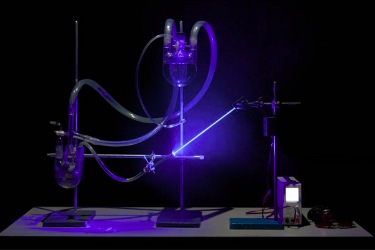
AIDS-3D & Paul B. Davis, "Miller-Urey Bong," 2010, mixed media. Courtesy the artists and Seventeen Gallery.
AF: The work you’ve produced and collaborated on this year all have a science fair feel to them — the admixing of programming, engineering, and science into aesthetically judged, functioning objects. Did you ever compete in math or science fairs?
A3D: We’ve been interested more and more in ideas of utility, and how those notions relate to the artistic process and role of the artist, and tried to execute projects that deal with our idealism, in contrast to our pragmatism as creative producers. But no, we never competed in any science fairs in school; we both intended to become artists in middle school. However, we read Science Daily as much or more than we read essays on e-flux. So it’s a main source of inspiration and excitement for us.
AF: Last week at Frieze, World Community Water Features exhibited in the Frame section with Gentili Apri. How was it showing the only Internet appliance on the floor?
A3D: Ha, well it’s safe to say that it was one of the weirdest booths in the Fair. It stuck out like a sore thumb, but we hope that people took that in a good way. A few reviewers’ comments seemed to miss the whole World Community Grid element and seemed to think we were designing some kind of lounge-room. One review called it “easily the least explicable booth in Frame,” which we take as a sort of sick badge of honor. But apparently once the gallerist managed to explain it to him (when the fountains are plugged in, the energy efficient PC connects to the WCG software, which donates the “unused” computer time to humanitarian causes), he “got” it. It’s always a challenge to show work with a hidden component which must be communicated in order to appreciate the work, and the effect is far worse in an art fair.
AF: Alternatively, what kind of energy would Ideal Work have conducted at Frieze?
A3D: Ideal Work is a series of decorative solar panels which gathers aura instead of light, so it probably would thrive compared to the Water Features! Though it has the same issue in that it’s essential to know what material it is, the work is more suitable for an art fair because it is self-contained and is focused on its own surface, which is sparkly and easy on the eyes.
AF: Many of your previous works kitschify ancient mythos of power. What are some of the models you used for works like Berserker or Ford/Aten, and how do you think your works engage in dialogue with the already displaced divine power motifs in the kitsch objects you’re copying?
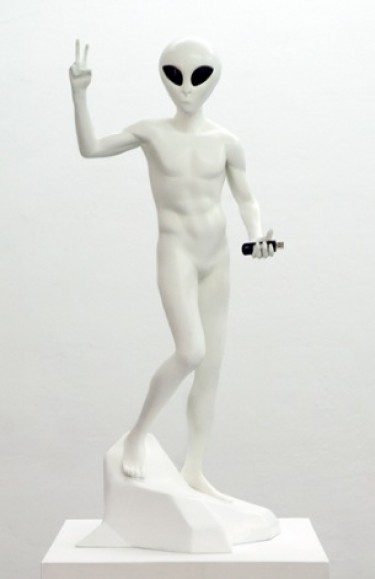
AIDS-3D, "Berserker," 2009. Styrofoam, acrylic, USB memory stick with 3D file. Courtesy the artists.
A3D: Its crucial that they are “strong images” which lost their divinity long ago, but remain in our collective conscience. They help make a familiar background noise to provoke the tensions between kitsch and the historical into exaggerating the unresolved questions of utility and entertainment. The model for Berserker is the standard alien head .gif translated into 3D, and a basic body from the program Poser. The Ford/Aten model is a rights-free laser-scan of a Tut souvenir. It is important that they look generic, but have actually been reconfigured to produce a kind of uncanny effect.
AF: Last year, in an interview with another Alex at Interview, Dan described Berlin as a really good place to grow. Since then you’ve gained gallery attention, and your sculptures have also rapidly transformed into “intelligent” sculptures which release commentary over time like a slow-release capsule. What has precipitated those changes?
A3D: Berlin is an ideal petri dish for us. We have lots of interesting artist friends and cheap enough rent that we don’t need side jobs to survive. But being in the The Generational: Younger than Jesus show had a legitimizing effect in the art world, especially amongst gallerists, it seems. It also forced us into a higher-visibility zone, where we felt we had to make more focused and mature work. Most of what we’d made before then, we’d thought of as experiments. We still want to make experiments and take risks, but we also don’t have the safety of doing it anonymously anymore. So we are trying to make sure our works form a more cohesive position, and the less interesting background noise is filtered out.
AIDS-3D, Heat Death, video loop on projector, 2009. Courtesy of the artists.
AF: Tell me about your upcoming series, Energy Conversion Devices.
A3D: We are going to have several European solo shows in the spring and under that title, we plan to unify recent and in-progress works which fit into the same rubric. It’s based in part on a theory called Digital Physics, which states that energy, matter, and information are all basically equitable. It from Bit. The pieces’ key element will be a broad definition of energy flow. The series will include a two part bondage screenplay for two readers whose roles are gradually reversed, as the authority giving camera that usually faces a teleprompter is replaced with another reader, and a series of collages with various “active-surfaces,” like the solar panel monochromes, along with forms made from silicon wafers, image sensor chips, holographic foils, ultra-black nanotubes, algae bio-reactors, and coated glass, just to give you a taste. We are hoping that the various parts will reinforce the totality of the concept and get people thinking about systems holistically.
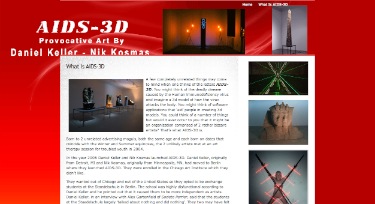
Artist unknown, aids-3d.org, website, 2010.
AF: https://aids-3d.org/: friend, foe or semi-web savvy critic?
A3D: We’ve been victims of cyber squatters! We had it for a long time as the dummy homepage of a “philanthropic investment” arm of AIDS-3D, we let the domain lapse, and someone stepped in… Would love to know who did it though.
DIMENSION/NEXT a collaborative exhibition by AIDS-3D and Paul B. Davis is now on view through November 13, 2010 at Seventeen Gallery in London.

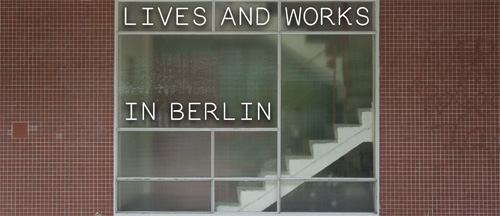
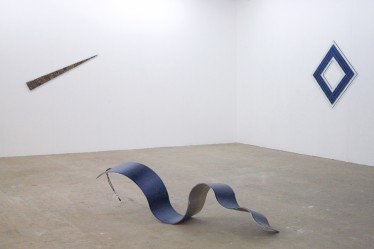




Pingback: Otto Piene’s Party Room, Duchamp and a Martini, Alec Soth, etc. [Collected] | 16 Miles of String: Andrew Russeth on Contemporary Art and Art History | ARTINFO.com